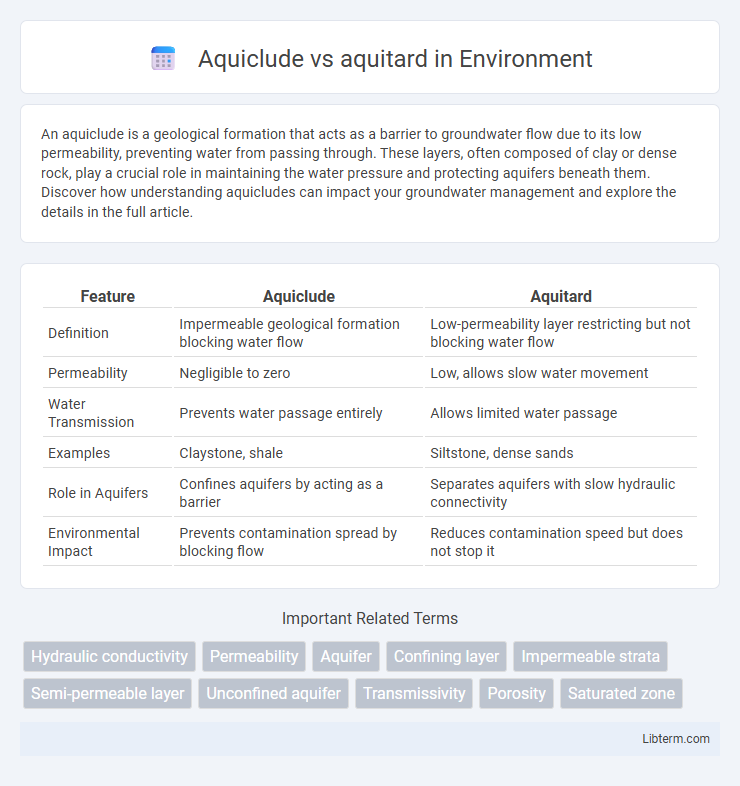An aquiclude is a geological formation that acts as a barrier to groundwater flow due to its low permeability, preventing water from passing through. These layers, often composed of clay or dense rock, play a crucial role in maintaining the water pressure and protecting aquifers beneath them. Discover how understanding aquicludes can impact your groundwater management and explore the details in the full article.
Table of Comparison
| Feature | Aquiclude | Aquitard |
|---|---|---|
| Definition | Impermeable geological formation blocking water flow | Low-permeability layer restricting but not blocking water flow |
| Permeability | Negligible to zero | Low, allows slow water movement |
| Water Transmission | Prevents water passage entirely | Allows limited water passage |
| Examples | Claystone, shale | Siltstone, dense sands |
| Role in Aquifers | Confines aquifers by acting as a barrier | Separates aquifers with slow hydraulic connectivity |
| Environmental Impact | Prevents contamination spread by blocking flow | Reduces contamination speed but does not stop it |
Introduction to Aquiclude and Aquitard
An aquiclude is a geological formation composed of impermeable rock or sediment that completely blocks the flow of groundwater, acting as a barrier to water movement. In contrast, an aquitard is a semi-permeable layer, such as clay or silt, that restricts but does not entirely prevent groundwater flow. Understanding the distinction between aquicludes and aquitards is essential for groundwater management, hydrogeology, and environmental engineering.
Definition of Aquiclude
An aquiclude is a geological formation that is completely impermeable to water, effectively preventing any groundwater flow. It acts as a confining layer that blocks the movement of water between aquifers, unlike an aquitard, which allows limited water transmission due to partial permeability. Understanding the role of an aquiclude is crucial in hydrogeology for groundwater management and contamination prevention.
Definition of Aquitard
An aquitard is a geological formation that restricts the flow of groundwater but does not completely stop it, contrasting with an aquiclude which is impermeable and prevents any water movement. Aquitards typically consist of materials like clay or silt that have low permeability, allowing slow water transmission. Understanding the distinction between aquitards and aquicludes is crucial for groundwater management and hydrogeological studies.
Key Differences Between Aquiclude and Aquitard
An aquiclude is a geological formation that is completely impermeable, preventing any water flow, whereas an aquitard allows limited water passage due to its semi-permeable properties. Aquicludes consist of dense materials like clay or unfractured rock, while aquitards are composed of less compacted sediments such as silts or fine sands. The key difference lies in their hydraulic conductivity, with aquicludes exhibiting near-zero permeability and aquitards demonstrating low but measurable permeability that influences groundwater movement.
Permeability and Water Movement
Aquicludes exhibit extremely low permeability, effectively preventing water movement and acting as impermeable barriers within aquifer systems. Aquitards have low to moderate permeability, allowing limited water flow that slows but does not completely stop groundwater movement. Understanding the contrast in permeability between aquicludes and aquitards is crucial for groundwater management and hydrogeological studies.
Geological Examples of Aquicludes
Aquicludes are geological formations that completely block the flow of groundwater due to their low permeability, such as shale, unfractured granite, and dense clay layers, which contrast with aquitards that restrict but do not entirely prevent water movement. Shale formations in the Appalachian Basin and thick clay layers in the Gulf Coastal Plain serve as classic examples of aquicludes, effectively trapping aquifers and influencing groundwater flow. These impermeable barriers play a critical role in hydrogeological systems by confining aquifers and affecting water resource management.
Geological Examples of Aquitards
Aquitards are geological formations with low permeability that restrict groundwater flow, often consisting of clay, silt, or shale layers, whereas aquicludes are completely impermeable rock layers, such as dense granite or unfractured limestone. Notable geological examples of aquitards include the clay-rich layers within the Dakota Sandstone Formation and the Pierre Shale in North America, which act as barriers slowing water movement. These sedimentary sequences commonly overlay more permeable aquifers, playing a crucial role in groundwater confinement and influencing the hydrogeological regime.
Importance in Groundwater Management
Aquicludes are impermeable geological formations that completely block groundwater flow, making them critical barriers for confining aquifers and preventing contamination spread. Aquitards, with low permeability, slow down groundwater movement and play a vital role in regulating aquifer recharge and discharge rates. Understanding the distinct hydraulic properties of aquicludes and aquitards is essential for effective groundwater resource management and sustainable water supply planning.
Role in Aquifer Protection
An aquiclude acts as a completely impermeable barrier, preventing any water flow and thereby offering maximum protection to aquifers by isolating them from contaminants. An aquitard, while significantly reducing groundwater flow, allows slow permeability, which can lead to limited but potential contaminant migration into the aquifer. Understanding the distinction between aquicludes and aquitards is critical for effective groundwater management and contamination prevention in hydrogeology.
Summary and Comparison Table
Aquicludes are impermeable geological formations that completely block water flow, while aquitards are semi-permeable layers that restrict but do not stop groundwater movement. Aquicludes typically consist of dense clay or unfractured rock, providing an effective barrier, whereas aquitards are usually composed of less compacted clay or silt allowing slow water passage. The comparison table highlights differences in permeability, hydraulic conductivity, and role in groundwater flow regulation, making aquicludes critical for confining aquifers and aquitards important for controlling recharge and discharge zones.
Aquiclude Infographic

 libterm.com
libterm.com